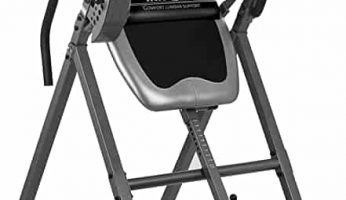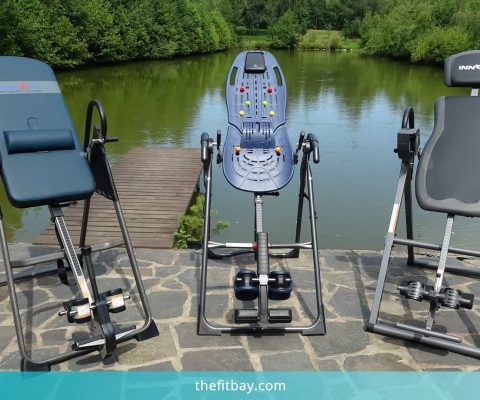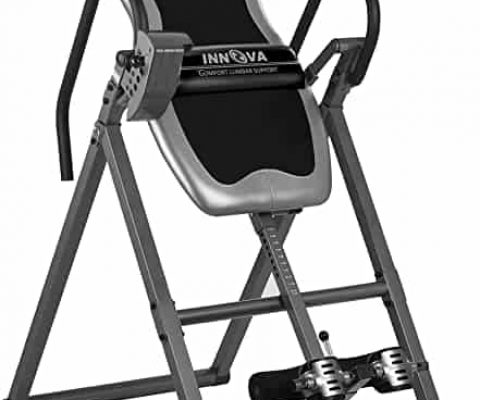Do Inversion Tables Help Sciatica?
Disclosure: We use affiliate links and may receive a small commission on purchases.
Are you currently suffering from lower back pain that travels down your leg? Have you ever been told by your doctor that you are suffering from something called “sciatica?” If you or anyone you know are dealing with sciatica, it can be quite debilitating.
Many people who suffer from sciatica seek effective forms of treatment. One such method is the use of the top inversion tables. Inversion tables strategically use gravity to provide decompression to tissues in the spine and lower extremity that may put pressure on the sciatic nerve. There is a growing body of evidence that supports the use of inversion tables as an effective method of relieving sciatica symptoms.
There are extra features that may be added to inversion tables. These will target body structures and specific symptoms that are directly correlated with sciatica, and may produce additional relief when compared to basic models of inversion tables.
Specific features of inversion tables that may be helpful for those suffering from sciatica include:
- Long and special handles to allow for deeper and more specific stretches of muscles that can be compressing the sciatic nerve
- Heat and massage features to relax muscles and decrease pain
- Acupressure Nodes to target specific areas of pain caused by muscles or joints

- Teeter EP-560 BPRK
-
Our rating - Lumbar Pad
- Price: See Here

Wrong simple review post
- Teeter EP-960 Ltd.
-
Our rating - Acupressure Nodes
This article will discuss sciatica, its causes, and look at detailed research on the effects of inversion tables on sciatica.
Next, we will learn about the anatomy of sciatica, common causes and symptoms, and how to use an inversion table for sciatica. Finally, we will discuss the recommended protocol for use of inversion tables, as well as effective exercises to perform while using these amazing tools.
3 Best Inversion Tables for Sciatica
1. Teeter EP-560 with Back-Pain Relief Kit

2. Innova ITM5900

3. Teeter EP-960 Ltd.
What Is Sciatica?
Sciatica is the irritation, inflammation, or entrapment of the sciatic nerve. The sciatic nerve is a major lower extremity nerve that has both sensory and motor functions throughout the leg.
The sciatic nerve branches off of the spinal cord as nerve roots through the openings on each side of the third and fourth lumbar vertebrae, the fourth and fifth lumbar vertebrae, and the fifth lumbar vertebrae and sacrum.
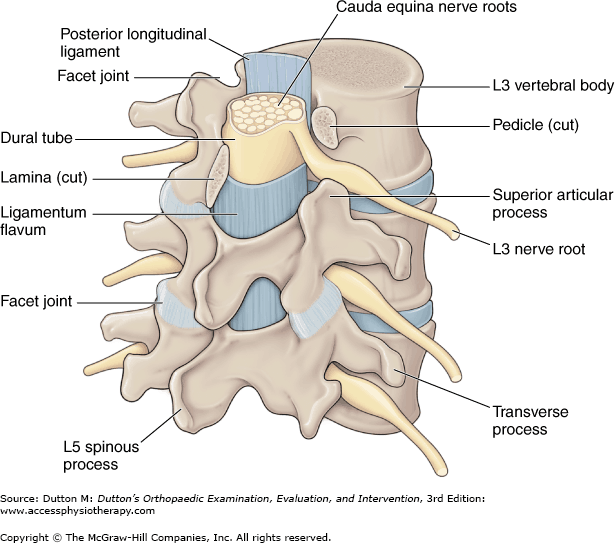
The nerve roots join together on either side and course through the hip below the buttocks, down the back of the thigh into the lower leg, and finally into the foot. There are several smaller nerves that branch from the sciatic nerve throughout it’s pathway that innervate certain parts of the lower extremity, and they can be affected if the sciatic nerve is compromised.
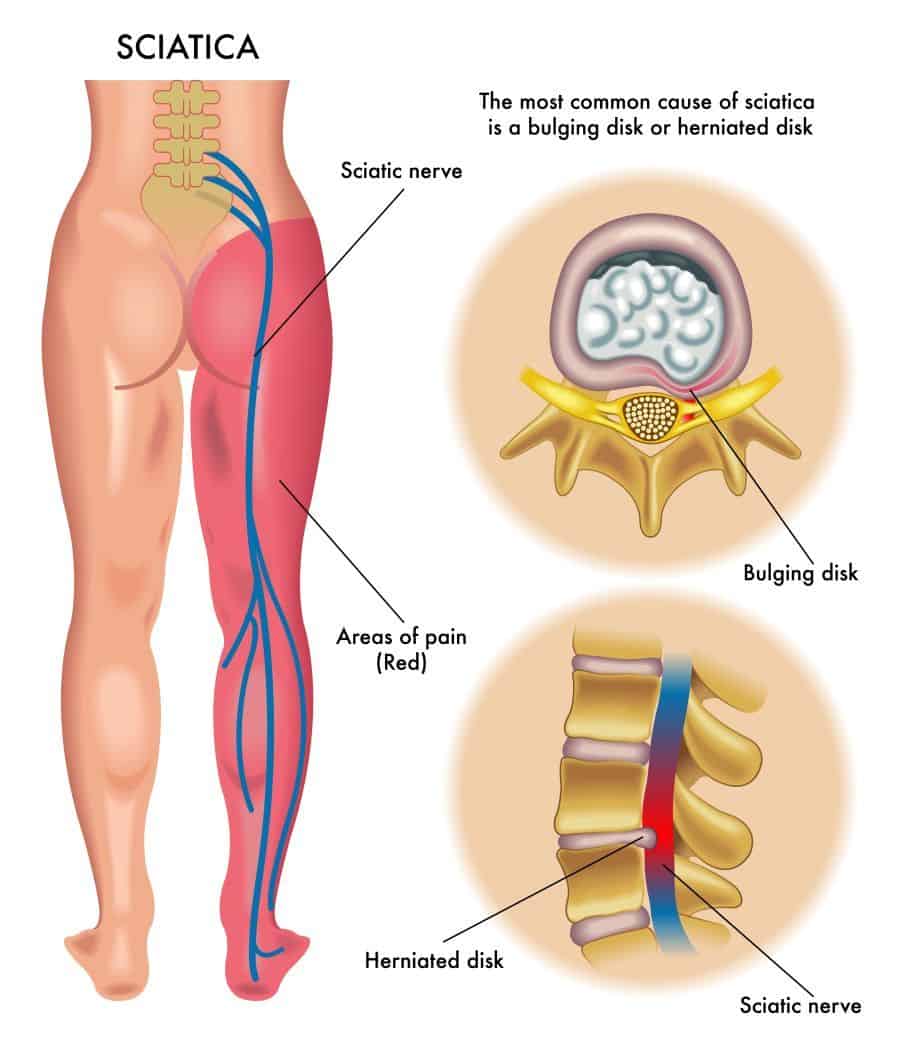
Technically speaking, true sciatica only manifests as symptoms in areas of the body that are innervated by the sciatic nerve. This means that symptoms in the front part of the leg are not likely to be caused by sciatica. However, such problems are a result of the same pathologies that cause sciatica, so inversion therapy can be as applicable of a treatment method for these symptoms.
What Are Common Symptoms of Sciatica?
Symptoms and limitations frequently associated with sciatica include but are not limited to:
- Pain in the lower back, back of the hip, thigh, lower leg, and into the foot, most notably in the great toe
- Numbness and tingling into these areas
- Weakness in muscles innervated by branches of the sciatic nerve
- Decreased reflexes of the lower extremity, particularly in the hamstring and calf muscles
- Pain with prolonged sitting or standing
- Pain with walking, particularly uphill
- Pain with bending and lifting
- Decreased flexibility or stiffness of the lower back, hip, hamstrings, or calf muscles
- Pain when putting on socks or shoes
- Pain with quick motions of the spine like turning or bending
- Difficulty climbing stairs
- Difficulty finding a comfortable position while sleeping
What Causes Sciatica?
There are several pathologies that may cause sciatica. Many of these issues can be traced back to structures of the lumbar spine. Refer to these images of the lumbar spine for explanation of the technical nomenclature of certain structures and how spinal mechanics affect the sciatic nerve.
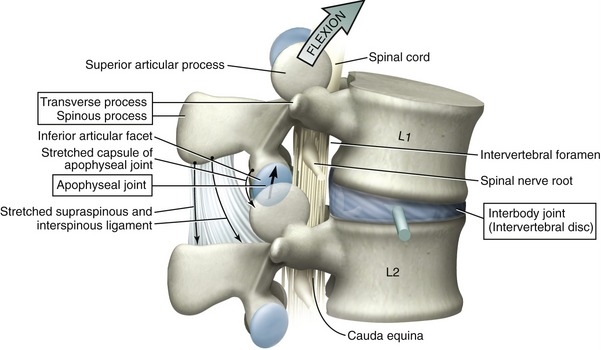
Listed below are some of the major causes of sciatica:
1. Lumbar disc pathologies
Between each of our spinal vertebrae lies a disc that is made up of a viscous fluid surrounded by a layer of thick fibers. The purpose of a disc is to provide shock absorption and a smooth surface on which the vertebrae can move.
Poor posture, bad lifting mechanics, traumatic injuries, or age related changes can cause the outer fibers of the disc to weaken, which in turn can cause part of the disc to push into the spinal canal or into the intervertebral foramen.
This can be harmless, but if enough of the disc has moved into these areas, it can put pressure on a nerve root, causing irritation, local inflammation, and pain. If the nerve roots affected are those that join to form the sciatic nerve, then you may experience symptoms into the back of your leg anywhere along the path of the sciatic nerve.
Additionally, discs may go through age related degenerative changes. With decreased disc height comes decreased space between the two vertebrae, and subsequently decreased space in the intervertebral foramen. This decreased space can put pressure on the nerve root and possibly cause sciatic symptoms.
A study conducted by Koes et al. found that the annual occurrence of disc related sciatica is about 2.2% in the general population. Additionally, this study estimated that up to 90% of all cases of sciatica are caused by disc related pathologies (1)
2. Lumbar facet joint pathologies
Facet joints are found at the top and bottom of each side of the vertebrae. Facet joints of one vertebra articulate with the facet joints of another vertebra to allow movements such as flexion, extension, rotation and side bending of the spine.
Facet joints can become restricted due to trauma, poor lifting mechanics, prolonged sitting or standing positions, poor sleeping postures, or with degenerative changes. Restrictions in these joints can cause pain, decreased range of motion, and symptoms radiating into the leg.
The radiating symptoms can be caused by increased pressure on the sciatic nerve roots due to the facet joint’s direct effect on the intervertebral foramen, or from the facet joint itself. Due to the compressive nature of both pain sources, inversion therapy can provide relief from either source.
3. Muscle hypertonicity and spasms
When someone experiences acute or chronic back pain, there is typically a component of muscle hypertonicity, or spasms. When the central nervous system senses tissue injury or even the threat of tissue injury, it sends signals to the surrounding muscles to tighten and protect the affected area.
Muscles can stay in protective mode from seconds to minutes, days, or even months as long as the central nervous system perceives a threat to important tissues. This prolonged increased resting tone of muscles can cause inflammation, formation of trigger points (painful knots in the muscle fibers), and increased pressure on surrounding structures.
This increased pressure from hypertonic muscles can put pressure on the sciatic nerve anywhere along its pathway and cause symptoms. These symptoms will likely worsen when the spasms are more intense.
4. Neural tension
Neural tension refers to the mobility restriction of a nerve at any point along its pathway. It can be caused by decreased space in the lumbar vertebrae, muscle hypertonicity along the nerve pathway, or by adhesions in the connective tissue around the nerve.
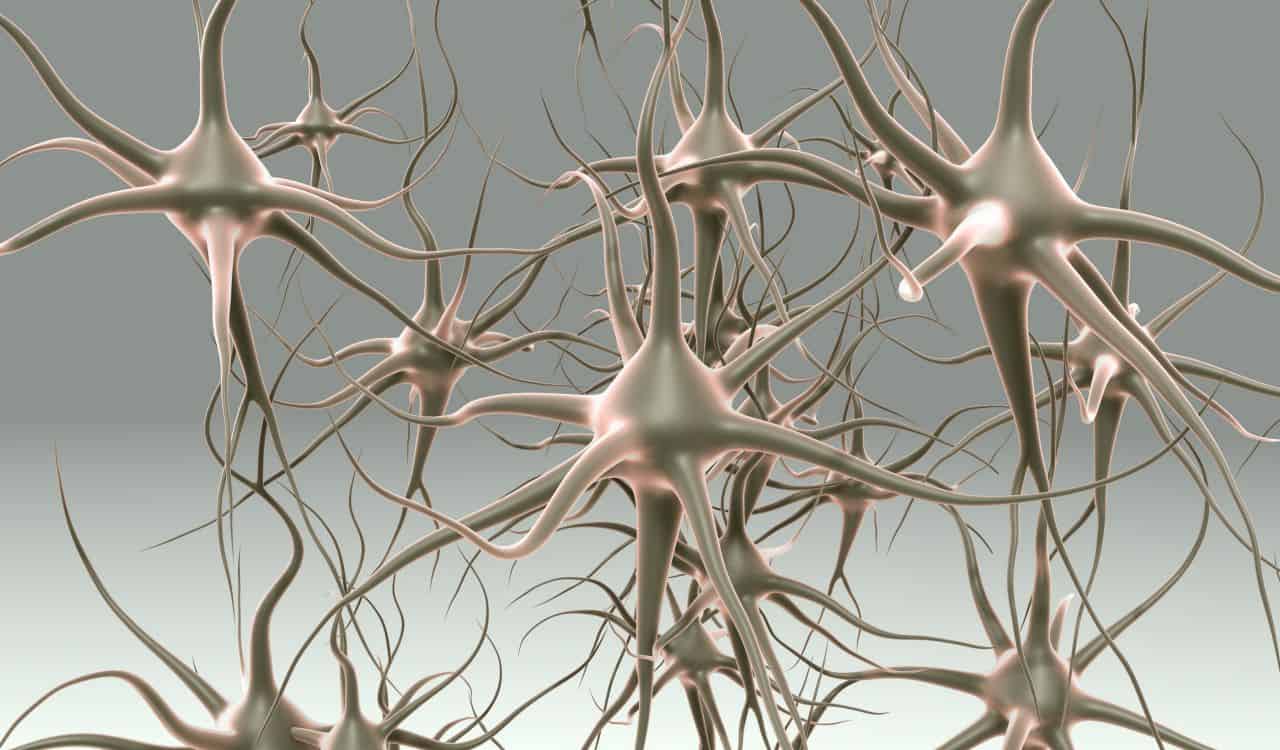
Although nerves do not have the same malleability as muscles, they still need to be able to shorten and lengthen as we move. If there is restriction in that mobility, then radicular symptoms will likely occur.
Common areas of sciatic nerve tension include:
- The intervertebral foramen
- The piriformis muscle (known as Piriformis Syndrome)
- The hamstrings
- The upper calf
Any of these pathologies can cause sciatica, and must be treated accordingly for effective symptom relief.
Several other factors are correlated with increased risk of sciatica, including:
- Postural stress and excessive lifting with poor mechanics
- Excessive amounts of driving
- Psychological distress
- Poor general health
- Obesity
- Smoking
Although none of these risk factors have shown causal relationships to sciatica, they are modifiable factors that are worth exploring to decrease overall risk for developing the pathology. (2)
The Prevalence of Sciatica in Society
Although much research has been conducted on the prevalence of sciatica in society, the findings greatly differ from study to study.
A systematic review conducted by Konstantinou and Dunn found the prevalence of sciatica to occur between 1.2% and 43% of adults during a given time period between the years of 1980 and 2006. While this number varies greatly, even taking the average of about 21% still represents a significant portion of the population and indicates that many people will combat sciatica at some point in their lifetime.
Another study performed on 674 working Mediterranean adults found that 266 (39.5%) participants reported low back pain in the previous 6-month period and that 166 (24.6%) participants reported symptoms of sciatica in the same time frame. (3)
When sciatic symptoms persist for weeks, months, or even years, the possibility of finding relief can seem hopeless at times. It is estimated that 20-30% of those who suffer from sciatica will have persisting symptoms for one or two years. (4)
However, current research supports many effective treatment methods for sciatica – one such treatment is inversion therapy.
Spinal Decompression Therapy with Inversion Tables
Now that you understand what might cause sciatica and how dysfunction of certain structures can contribute to these symptoms, let us discuss spinal decompression and how inversion tables apply this as an effective means to treat sciatica.
Spinal decompression refers to the use of traction or distraction forces to increase space between the vertebrae where the sciatic nerve begins. The goal of spinal decompression in relation to sciatica is to address any of the above pathologies in order to reduce pain and radicular symptoms. When spaces between vertebrae are increased, this can temporarily improve disc height, facet joint space, intervertebral foramen size, and decrease muscle hypertonicity.

With these improvements, pressure on the sciatic nerve roots can decrease, and symptoms caused by sciatica will likely reduce. Additionally, improvements in range of motion, strength, and activity tolerance may also be demonstrated for varying lengths of time following decompression.
One way to accomplish spinal decompression is to use gravity. Inversion tables are a popular method that use gravity to achieve spinal decompression. Several studies have supported the use of inversion tables as an effective form of symptom relief in those with sciatica.
Do Inversion Tables Work for Sciatica?
Yes, inversion tables are effective in relieving symptoms caused by sciatica. There are several scientific studies that support this.
One of the most promising studies on inversion table’s effects on sciatica came from Prasad et al. The study concluded that of all participants who were told they needed surgery for their sciatica symptoms, only 23% of those in the inversion therapy group needed surgery as compared to the 78% of those without inversion. (5)
Studies examining the effects on individuals who were unable to work due to sciatica symptoms show favorable results when using inversion as a primary intervention. It is estimated that up to 88.5% of people can return to work full time after a short number of treatment sessions, and that the number of sick days taken due to sciatic symptoms reduced 33%. (6, 7)
Other studies conducted using inversion as the experimental intervention demonstrate that there is an increase in disc height, intervertebral space, and spinal length during and immediately following inversion. (8, 9, 10, 11) This is significant, as increased space and disc height allows for decreased neural pressure and therefore a subsequent relief in symptoms from sciatica.
Research also supports inversion tables as a low-risk intervention for low back pain. (12)
In addition to the multitude of studies which support inversion as an effective treatment for sciatica, continued research is being conducted to solidify its efficacy for long term use.
How to Use and Inversion Table for Sciatica
There is no current specific protocol for the use of inversion tables, likely because of the infancy of the device and the limited research on the topic. The following recommendations are strictly based on my knowledge as a physiotherapist about sciatica, spinal issues, and inversion therapy.
These recommendations are ordered from the complete beginner stage or those with significantly high pain levels, to the more experienced level or those with lower levels of pain.
- Low decline
This is a decline set between 15 and 30 degrees. If it is your first time on an inversion table, start at this level. You may choose to relax here or perform exercises, and do so anywhere between 5 to 20 minutes as tolerated. - Moderate decline
This is a decline between 30 and 60 degrees. Once you are comfortable with the low level of decline, begin gradually working your way into this range. You may choose to only hang in the beginning but then perform exercises here as you become more comfortable. Perform any time between 5 and 20 minutes as tolerated. - High decline
This is a decline between 60 and the most advanced setting of 90 degrees. It is recommended that you only perform these ranges if you have been comfortable with the previous two.
Begin with simply hanging at the desired decline angle. Once you have become comfortable with hanging, then you may perform exercises later outlined in this article. Perform the activity of your choosing for 5 to 20 minutes as tolerated.
Inversion Table Sciatica Exercises
While inversion therapy can be an effective form or symptom relief and temporary improvements in function, specific exercise has been shown in multiple studies to decrease symptoms and limitations from back pain and sciatica both on its own and with other treatments.
One of the most beneficial aspects of inversion therapy is its ability to immediately improve symptoms so that you can move with more ease. This means that you can use inversion tables and then immediately follow it up with movements that you were not previously able to achieve. Furthermore, you can even do stretches and stabilization exercises while on the inversion table so that you can teach your body how to move in these newly acquired pain free ranges.
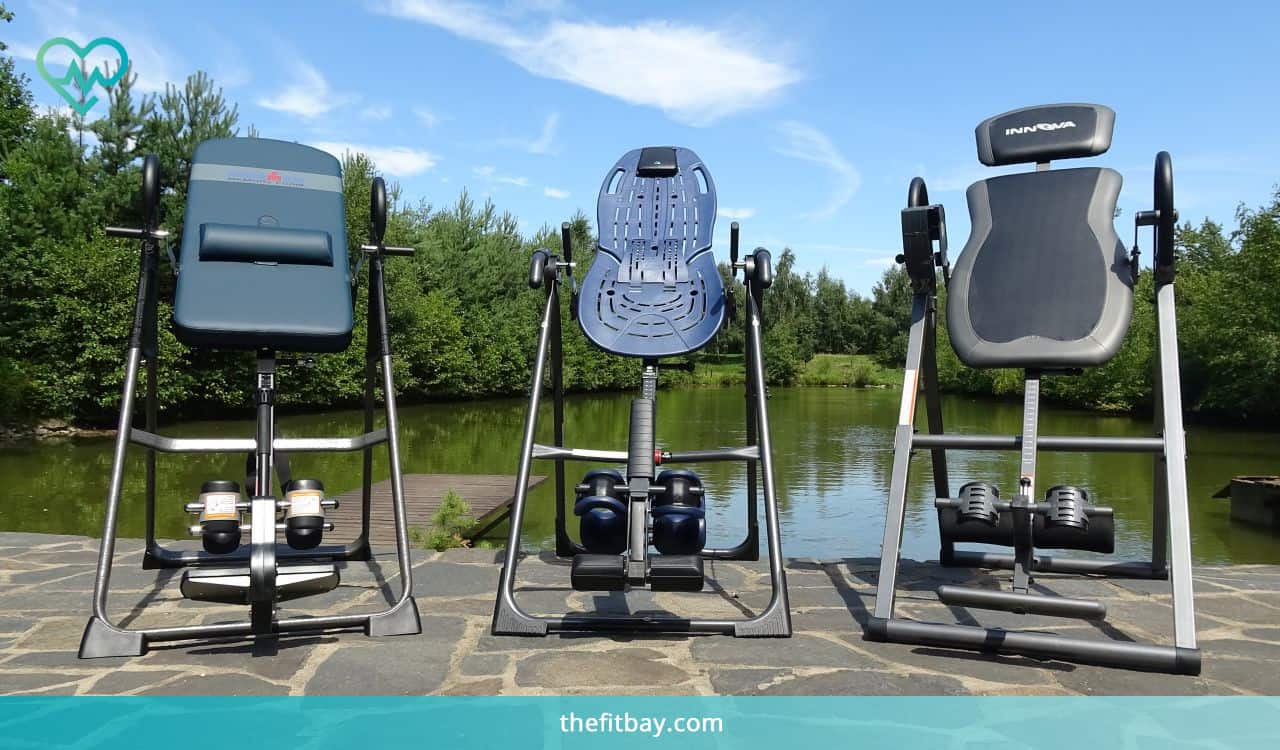
Here is a list of exercises you can do while on an inversion table that will help your range of motion and pain. These are listed from least difficult to most difficult.
1. Diaphragmatic breathing
Many people with back pain do not adequately engage their diaphragm while breathing. The diaphragm is the main muscle of inspiration, using pressure changes to inhale and exhale air. People who do not properly engage their diaphragm will interrupt proper core stabilization with activity which can lead to back pain.
This exercise is simple. Just hang from your inversion table at the desired angle, and practice filling you stomach up with air. You should focus on your stomach rising and not your chest.
If you have trouble with this, put one hand on your stomach and one on your chest. The hand on your stomach should rise significantly sooner than the one on your chest. If your chest rises first, you are overusing accessory muscles for breathing and not engaging your diaphragm.
Diaphragmatic breathing is great for those who are in significantly high levels of pain, as well as for beginners on inversion tables. There is no recommendation of how many repetitions should be performed, so try this exercise for as long as desired.
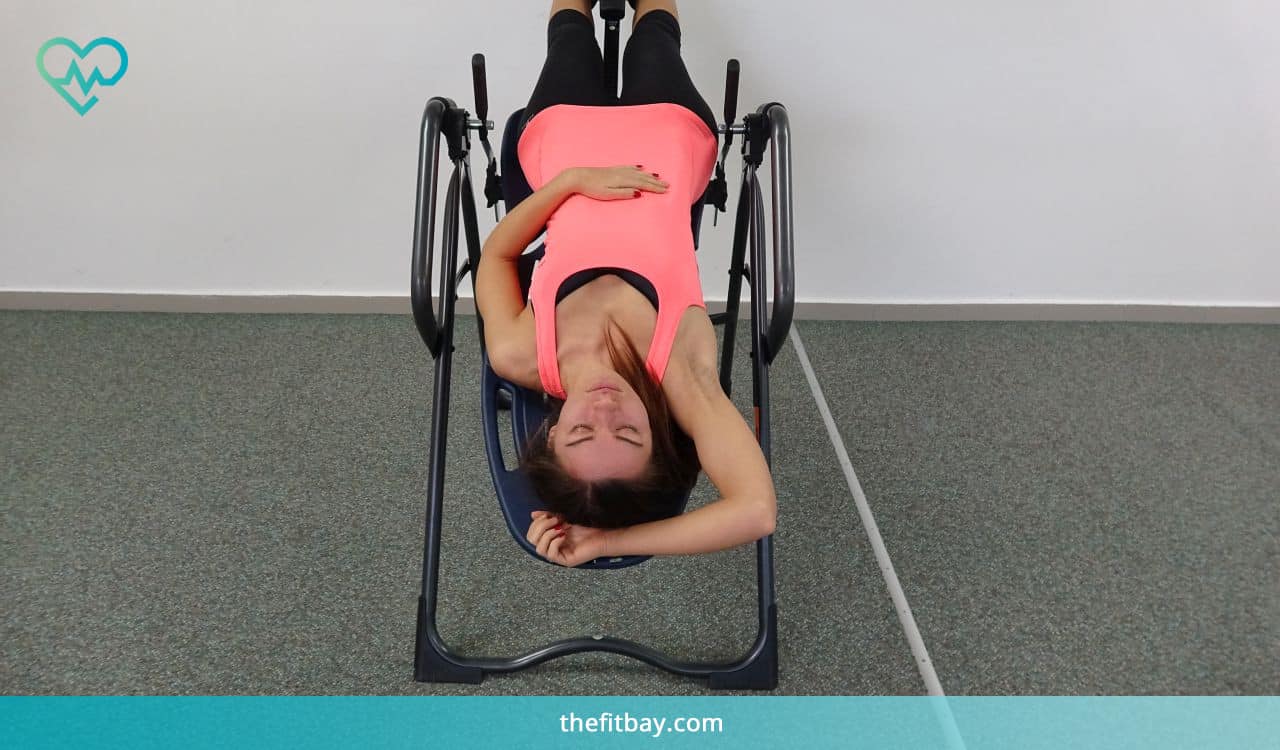
2. Trunk rotations
This is a simple exercise to stretch the lower back muscles and improve your ability to rotate. After setting the table to the desired angle, reach your right arm across your body and grab the bar on your left. Hold for about 5 to 10 seconds and repeat towards the other side. Perform 10 repetitions to each side.
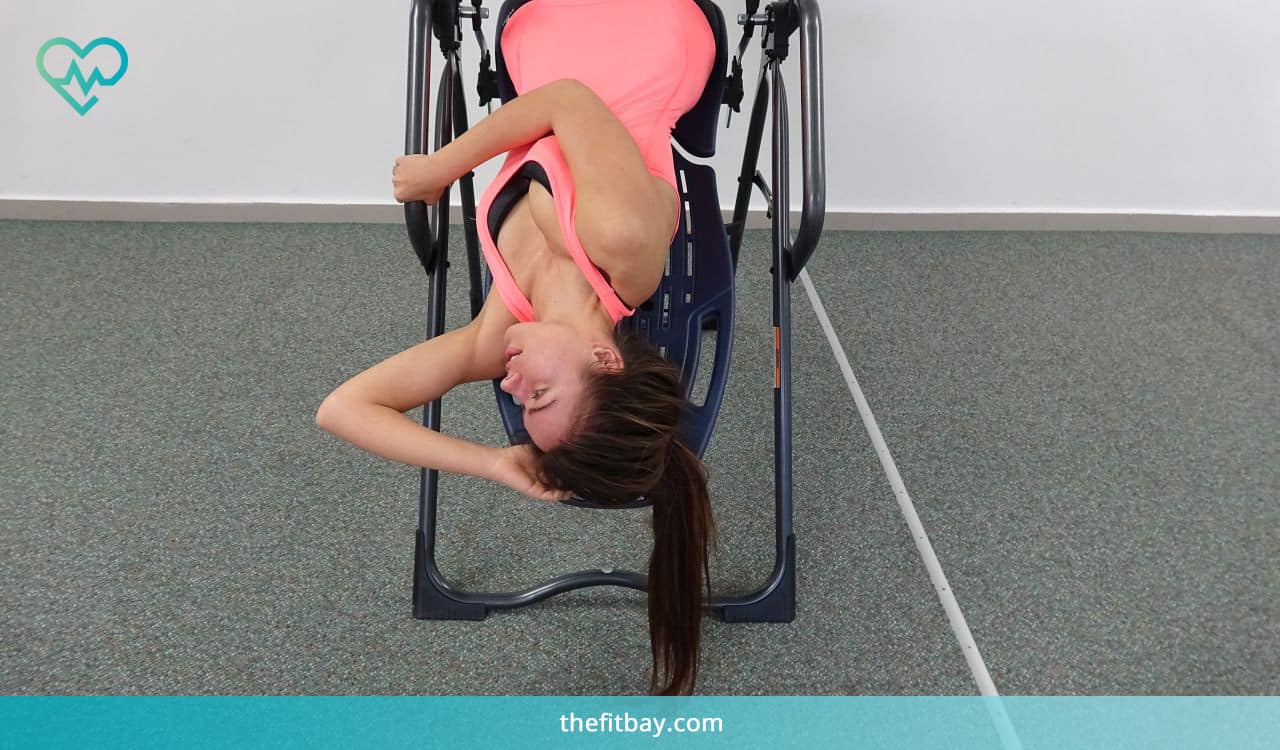
3. Overhead stretch
This is another simple stretch to help side bending of the lumbar spine. After setting the table at the desired angle, reach your right arm over your head and then towards the left side. You should feel a gentle stretch on the right side of your lower back and maybe into your shoulder. Hold this stretch for about 5 to ten seconds and repeat towards the other side. Perform 10 repetitions to each side.
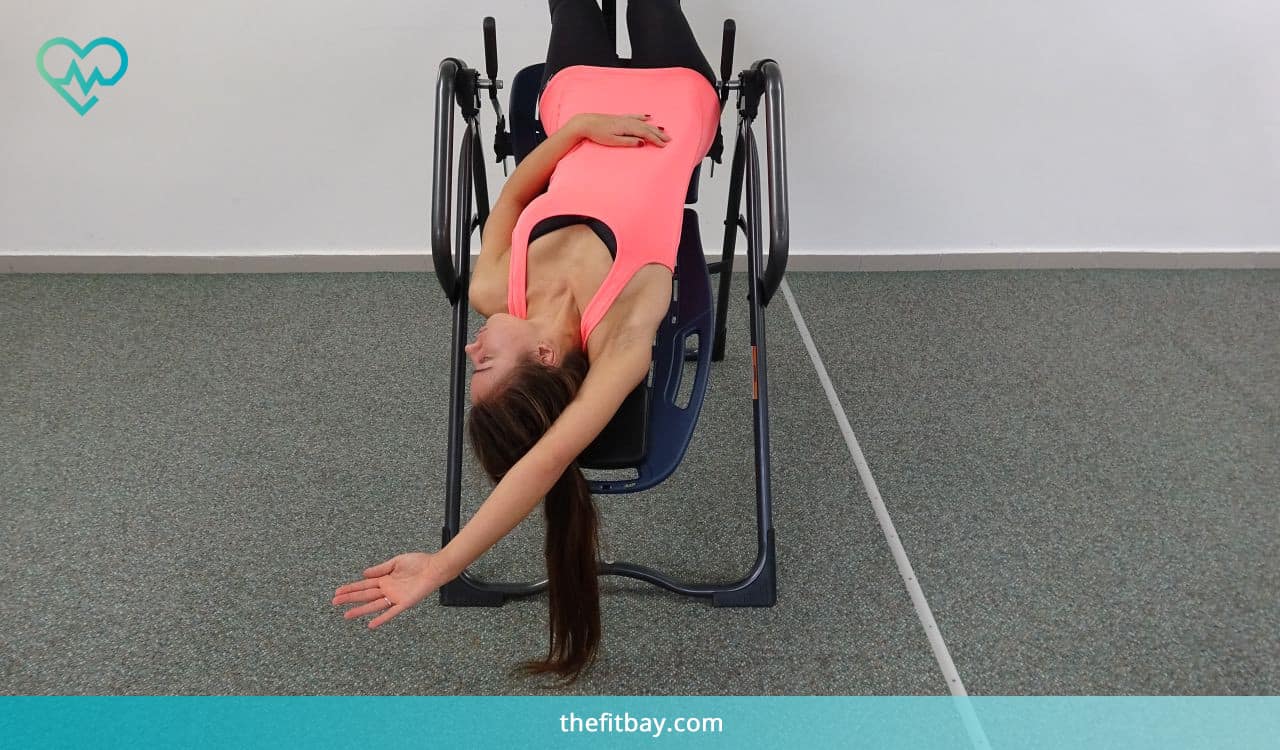
4. Pelvic tilts
This is an exercise to work on flexion and extension, as well as control of your lumbar spine. After setting your table to the desired angle, engage your core muscles and try to flatten you back against the table. Hold this position for 5 seconds.
Next, arch your back in the opposite direction so that there is a space between your lower back and the table. Hold this position for 5 seconds. Repeat each direction 20 times.
You should only move into a range that is comfortable for you. If you have significant increase in your symptoms in a certain range of the motion, decrease your range to a more comfortable position and increase your range when you feel able.
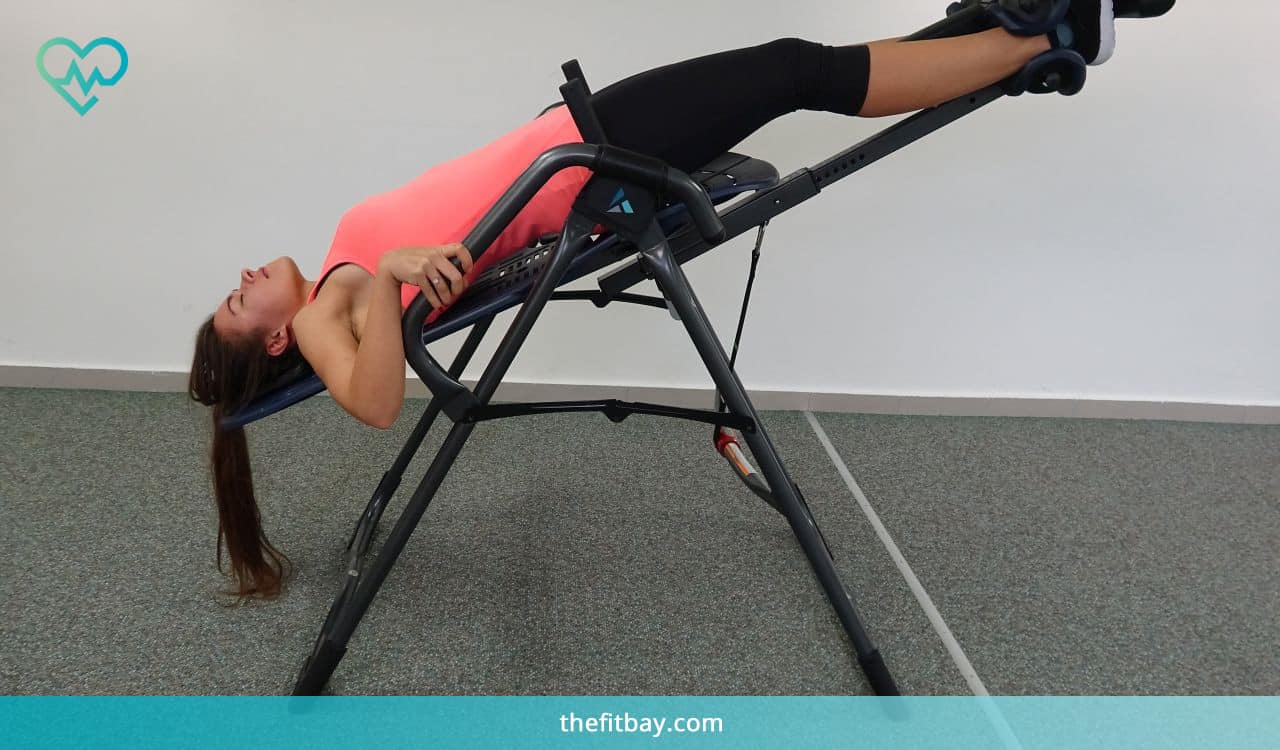
5. Crunches
This is an exercise to help with abdominal strength and core stability. First, set the table to the desired angle. Put your hands behind your head or over your chest, contract your abdominals, and crunch your shoulders off of the table.
Perform 20 repetitions and take a rest break. Ensure that you are breathing throughout the exercises. It is recommended that you inhale as you descend from the crunch and exhale during the ascent.
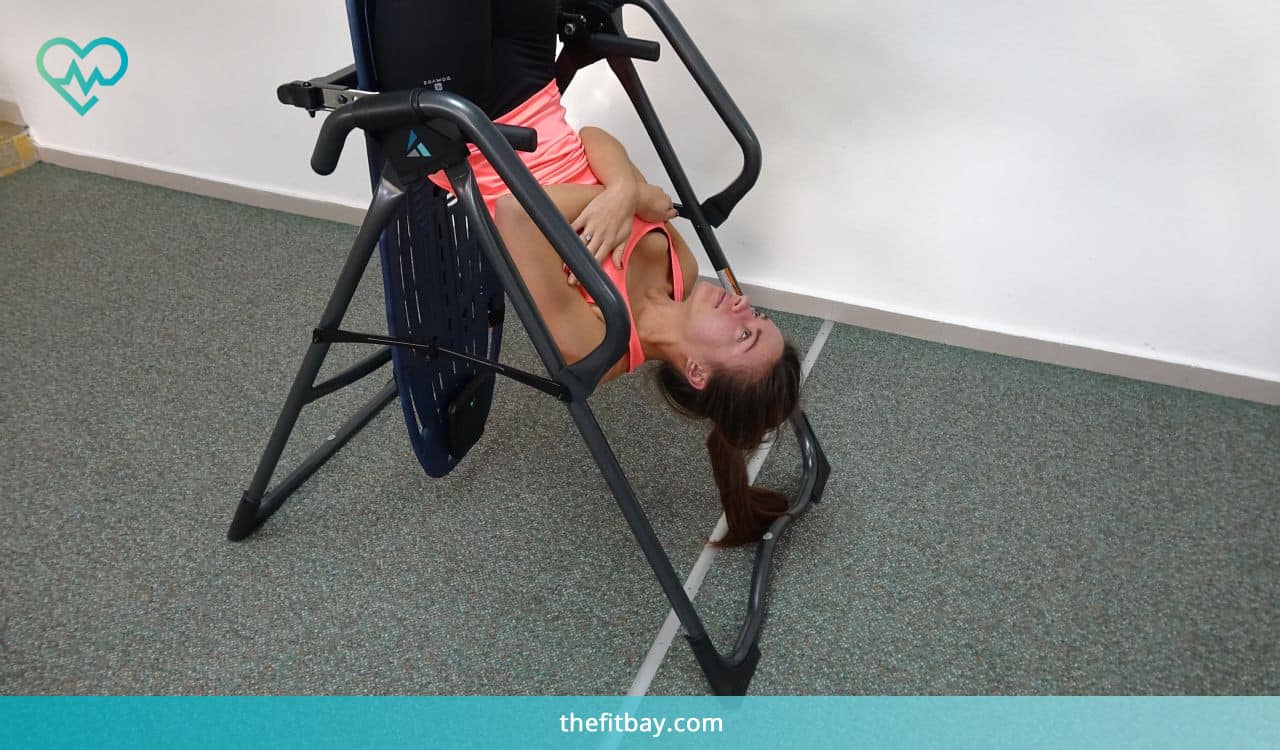
Summary
Sciatica is a common problem that is encountered by up to 43% of people in their lifetime, and can be debilitating for individuals who suffer from it. There are a variety of causes and risk factors that can contribute to sciatica, with the most common being lumbar disc injuries.
Inversion therapy has been shown to have benefits in relieving sciatic symptoms. Inversion tables are a convenient and overall safe intervention that individuals with sciatica can perform and progress as a home-remedy to their symptoms. They can also be combined with exercise to create more pain free movement, facilitate improved function and return to normal daily and work activities.
There are numerous studies that support the use of inversion tables as an effective form of treatment for sciatica, and continued research is being conducted to solidify its efficacy for long term use.
For those suffering from sciatica, an inversion table could be an exciting new way to approach and improve your symptoms.





